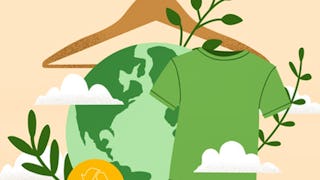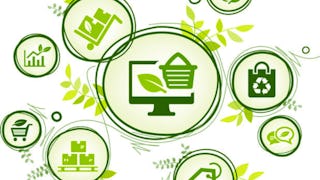Circular Product Design Frameworks and Certifications is the third and final course of the Circular Product Development for the Circular Economy specialization. The aim of this course is to explore different circular design frameworks such as the Ellen MacArthur Foundation's collaboration with IDEO to create a Circular Product Design Guide, the partnership between industry and research teams that culminated in the CIRCit Guide to Circular Product Design and Development, and Biomimicry 3.8's Guide to best practices. If the first two courses in the specialization describe what circular product and packaging design is and what it can achieve, this course is about the processes and methodologies necessary to make it happen.



Circular Product Design Frameworks and Certifications
包含在 中
您将学到什么
Make informed eco-design decisions by identifying and applying circular design criteria from three very different design frameworks.
Understand and apply design guidelines from the EMF-IDEO framework, the CIRCit Design Model, and Biomimicry.
Explain the 5 areas associated with the C2C Certification Process and why the process is important in transitioning to a more circular economy.
Evaluate a product and packaging for its degree of circularity using Circularity Assessment Tools and C2C certification requirements.
您将获得的技能
要了解的详细信息

添加到您的领英档案
18 项作业
了解顶级公司的员工如何掌握热门技能

积累特定领域的专业知识
- 向行业专家学习新概念
- 获得对主题或工具的基础理解
- 通过实践项目培养工作相关技能
- 获得可共享的职业证书

该课程共有4个模块
Welcome to Circular Product Design Frameworks and Certifications! This is the third and final course in the Sustainable and Circular Product Development Specialization. This first module begins with an introduction to the course and how it works. We then get into product design and the frameworks that exist to help promote more sustainable and circular product design, such as the Cradle-to-Cradle (C2C) product design method, a methodology based on a partnership between the Ellen MacArthur Foundation and IDEO, and a design strategy based on Biomimicry. We then explore the regulatory side of circular product design, referencing the European Union's recently enacted "Ecodesign for Sustainable Products Regulation", or ESPR. Using smartphones as an example, we learn about the ESPR's ecodesign requirements, and how we as consumers gain insights to a products sustainability credentials. Finally, we examine the strategies of a company that has had sustainability at its core for decades: IKEA. We learn how IKEA applies principles of the circular economy to its products through its Circular Product Design Guide, and how that is based on IKEA's overall goal of Transitioning to a Circular Business by 2030.
涵盖的内容
10个视频11篇阅读材料4个作业1个讨论话题
The Ellen MacArthur Foundation (EMF) has been central in providing tools and ideas for accelerating the Circular Economy. The EMF teamed up with IDEO, an internationally recognized product design firm, to create the EMF-IDEO Circular Design Guide. It is a valuable framework for achieving a circular product design through its detailed, step-by-step process complete with many worksheets and activities. The Framework consists of 4 steps: Understand, Define, Make and Release. These steps align with IDEO's Human-Centered Design and Design Thinking approaches to product design, now incorporating principles of the circular economy. In this module, we describe IDEO's overall approach to product design, and then detail each step of the EMF-IDEO Circular Product Design Framework in a manner that enables the Design Team to go through the process themselves, and ultimately identify the circular product design to take forward into production.
涵盖的内容
9个视频8篇阅读材料5个作业
While the Ellen MacArthur Foundation-IDEO Circular Design Framework is a well-known approach towards transitioning to greater circularity, other valuable frameworks exist as well. Notably, the CIRCit Project, conducted by a team from academia, research centers and industry, established a circular design guideline that can be incorporated directly into more conventional stage-gate product development processes. The CIRCit approach to Circular Product Design and Development is explored in detail in this module, especially as it applies to the early stages of product development. In addition, linking product design to nature is a common theme among many guidelines. The field of biomimicry encourages innovation by looking to nature for solutions. The Biomimicry Institute and its sister-organization, Biomimicry 3.8, have established a design guide that helps product developers learn how to apply the principles of biomimicry into their design process. This module also explores this novel approach to circular product design.
涵盖的内容
10个视频7篇阅读材料3个作业
Many companies are ramping up their efforts to ensure their products are more sustainable and circular, whether to comply with the new European Union’s eco-design regulations, or because customers are seeking products that better reflect their own values of social and environmental responsibility. Yet how would consumers know whether a product is truly circular or not – and to what degree? One approach is the use of a 3rd party certification. By having a 3rd party evaluate and assess a product’s circularity relative to a rigorous set of standards, the company’s claims become quite credible. This 4th and final module of the course explores a 3rd party certification process that comes from the Cradle-to-Cradle Products Innovation Institute, the non-profit spun out from the Cradle-to-Cradle organization. Products can achieve levels of Bronze, Silver, Gold or Platinum, with the requirements for each certification level are captured in a document called the Cradle-to-Cradle Product Standard. This module examines the most recent product standard in some detail, notably version 4.1, which takes effect in 2025. Certification depends on progress on 5 different focus areas: Material Health, Product Circularity, Clean Air and Climate Protection, Water and Soil Stewardship, and Social Fairness. In this module, you will go through each of these to get a better understanding of what it takes to get a product certified as sustainable and aligning with the principles of the circular economy.
涵盖的内容
11个视频7篇阅读材料6个作业
获得职业证书
将此证书添加到您的 LinkedIn 个人资料、简历或履历中。在社交媒体和绩效考核中分享。
攻读学位
课程 是 University of Colorado Boulder提供的以下学位课程的一部分。如果您被录取并注册,您已完成的课程可计入您的学位学习,您的学习进度也可随之转移。
位教师

从 Environmental Science and Sustainability 浏览更多内容

University of Colorado Boulder

University of Colorado Boulder
人们为什么选择 Coursera 来帮助自己实现职业发展




常见问题
To access the course materials, assignments and to earn a Certificate, you will need to purchase the Certificate experience when you enroll in a course. You can try a Free Trial instead, or apply for Financial Aid. The course may offer 'Full Course, No Certificate' instead. This option lets you see all course materials, submit required assessments, and get a final grade. This also means that you will not be able to purchase a Certificate experience.
When you enroll in the course, you get access to all of the courses in the Specialization, and you earn a certificate when you complete the work. Your electronic Certificate will be added to your Accomplishments page - from there, you can print your Certificate or add it to your LinkedIn profile.
Yes. In select learning programs, you can apply for financial aid or a scholarship if you can’t afford the enrollment fee. If fin aid or scholarship is available for your learning program selection, you’ll find a link to apply on the description page.
更多问题
提供助学金,






